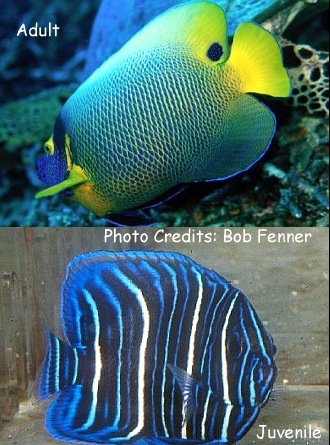
By Bob Goemans

Not Reef Tank Suitable
Likely Fish-Only Tank Suitable
Range: Indo-West Pacific Ocean: Southern Japan, Taiwan, south to Malaysia, Indonesia, Philippines, Micronesia and south to northern Australia.
Size: 15 inches (38 cm)
Natural Environment: Inhabits coral rich areas near steep drop-offs, patch reefs, outer reef slopes and also in protected lagoons at depths of 15 to over 150 feet (5 – 45 m). Feeds on sponges, tunicates, and algae.
General Husbandry: Both the juvenile and adult are quite pretty and hardy, with the juveniles being overall blue black with numerous vertical white bands that are separated by thin pale blue lines that become somewhat curved as they reach the tail. As for the adult, it has an overall yellowish body, blue face with a yellow band across the forehead from eye to eye. Its body scales are all highlighted in blue, giving the entire body a gorgeous pattern of interwoven blue and yellow! Its tail is yellow, as is its dorsal and anal fins, and all are edged in bright blue. Pectoral fins are yellow, pelvic fins dark blue and edged in bright blue, and there is a dark blue spot at the base of the rear dorsal fin. Probably the most beautiful of all angelfish in this genus!
When first introduced into the aquarium, preferably a well-established fish-only aquarium with lots of live rock and cave areas, adults or juveniles should be offered numerous daily feedings so as to quickly acclimate it to its surroundings. Like many others in this genus, their captive diet should consist of a wide variety of frozen foods including fortified brine shrimp, mysis, and especially those containing sponge matter/angelfish food preparations and continued to be offered at least several times daily after its acclimated to its surroundings. Furthermore, flake foods, and especially those containing Spirulina and/or Nori should be also offered, along with fresh broccoli and macroalgae, as ‘greens’ make up a portion of this species diet, especially the juveniles and subadults.
Depending upon its tankmates, juveniles may be somewhat shy when first entering the aquarium, and may hide in caves and crevices. But as time passes, will become more outgoing and begin to establish its territory. As for adults, it’s not as feisty as those in the Holacanthus genus, yet it all depends on aquarium size and tankmates, but its preferable it is the last angelfish to be added to the aquarium.
Taxonomy:
Order: Perciformes
Suborder: Percoidei
Family: Pomacanthidae
Genus: Pomacanthus
FYI: Keeping more than one genus of angelfishes in the same aquarium is possible, yet depends upon several aspects. The following suggested circumstances are just that, possibilities that when heeded and adjusted to actual aquarium conditions ‘may’ make multiple angelfish collections feasible.
Aquarium size – the larger the better.
Species from the same genus should not be in the same aquarium.
The smallest and most docile genus species should be the first introduced with the largest and most malicious the last to be added.
Do not place similar coloration species in the same aquarium.
Those already in the aquarium should be well fed before adding a newcomer.
Have sufficient hiding places/rocky caves.
Do not overfeed meaty foods, especially juveniles, as it may lead to a fatty deposit around the liver that could stop production of vitamin A. This could cause blindness, often referred to as nutritional blindness.
Keep in mind all angels have cheekspines at the edge of their gill cover; therefore use caution when handling and also avoid using a net to capture it, as it may become stuck or tangled in the net and become damaged when removed.
Experience Level: Intermediate
Temperament: Semi-aggressive
Diet: Omnivore
Acclimation Time: 30 minutes+
Aquarium Environment: Fish-only and Reef Aquariums (See Below)
Reef Safe: Juveniles – Yes/Adults - No - will nip clam mantles, large and small polyped stony (LPS/SPS) corals, and also some soft corals and tubeworms.
Minimum Tank Size: 150 gallons
Temperature Range: 72 - 81°F (22 – 27°C)
Specific Gravity: 1.020 - 1.026
pH: 8.0 - 8.5
